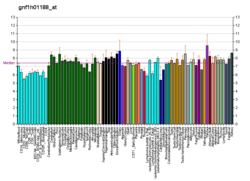| NACC1 |
|---|
|
|
| Identifiers |
|---|
| Aliases | NACC1, BEND8, BTBD14B, BTBD30, NAC-1, NAC1, nucleus accumbens associated 1, NECFM |
|---|
| External IDs | MGI: 1914080 HomoloGene: 12042 GeneCards: NACC1 |
|---|
|
| Gene location (Mouse) |
|---|
 | | Chr. | Chromosome 8 (mouse)[2] |
|---|
| | Band | 8 C2|8 41.02 cM | Start | 84,670,483 bp[2] |
|---|
| End | 84,687,862 bp[2] |
|---|
|
|
| Orthologs |
|---|
| Species | Human | Mouse |
|---|
| Entrez | | |
|---|
| Ensembl | | |
|---|
| UniProt | | |
|---|
| RefSeq (mRNA) | | |
|---|
| RefSeq (protein) | | |
|---|
| Location (UCSC) | Chr 19: 13.12 – 13.14 Mb | Chr 8: 84.67 – 84.69 Mb |
|---|
| PubMed search | [3] | [4] |
|---|
| Wikidata |
|
Nucleus accumbens-associated protein 1 is a protein that in humans is encoded by the NACC1 gene.[5][6]
Further reading
- Nakayama K, Nakayama N, Wang TL, Shih IeM (2007). "NAC-1 controls cell growth and survival by repressing transcription of Gadd45GIP1, a candidate tumor suppressor". Cancer Res. 67 (17): 8058–64. doi:10.1158/0008-5472.CAN-07-1357. PMID 17804717.
- Davidson B, Berner A, Trope' CG, et al. (2007). "Expression and clinical role of the bric-a-brac tramtrack broad complex/poxvirus and zinc protein NAC-1 in ovarian carcinoma effusions". Hum. Pathol. 38 (7): 1030–6. doi:10.1016/j.humpath.2006.12.009. PMID 17391728.
- Nakayama K, Nakayama N, Davidson B, et al. (2007). "A BTB/POZ protein, NAC-1, is related to tumor recurrence and is essential for tumor growth and survival". Proc. Natl. Acad. Sci. U.S.A. 103 (49): 18739–44. doi:10.1073/pnas.0604083103. PMC 1693732. PMID 17130457.
- Korutla L, Wang PJ, Mackler SA (2005). "The POZ/BTB protein NAC1 interacts with two different histone deacetylases in neuronal-like cultures". J. Neurochem. 94 (3): 786–93. doi:10.1111/j.1471-4159.2005.03206.x. PMID 16033423.
- Gerhard DS, Wagner L, Feingold EA, et al. (2004). "The Status, Quality, and Expansion of the NIH Full-Length cDNA Project: The Mammalian Gene Collection (MGC)". Genome Res. 14 (10B): 2121–7. doi:10.1101/gr.2596504. PMC 528928. PMID 15489334.
- Beausoleil SA, Jedrychowski M, Schwartz D, et al. (2004). "Large-scale characterization of HeLa cell nuclear phosphoproteins". Proc. Natl. Acad. Sci. U.S.A. 101 (33): 12130–5. doi:10.1073/pnas.0404720101. PMC 514446. PMID 15302935.
- Ota T, Suzuki Y, Nishikawa T, et al. (2004). "Complete sequencing and characterization of 21,243 full-length human cDNAs". Nat. Genet. 36 (1): 40–5. doi:10.1038/ng1285. PMID 14702039.
- Korutla L, Wang PJ, Lewis DM, et al. (2002). "Differences in expression, actions and cocaine regulation of two isoforms for the brain transcriptional regulator NAC1". Neuroscience. 110 (3): 421–9. doi:10.1016/S0306-4522(01)00518-8. PMID 11906783.





